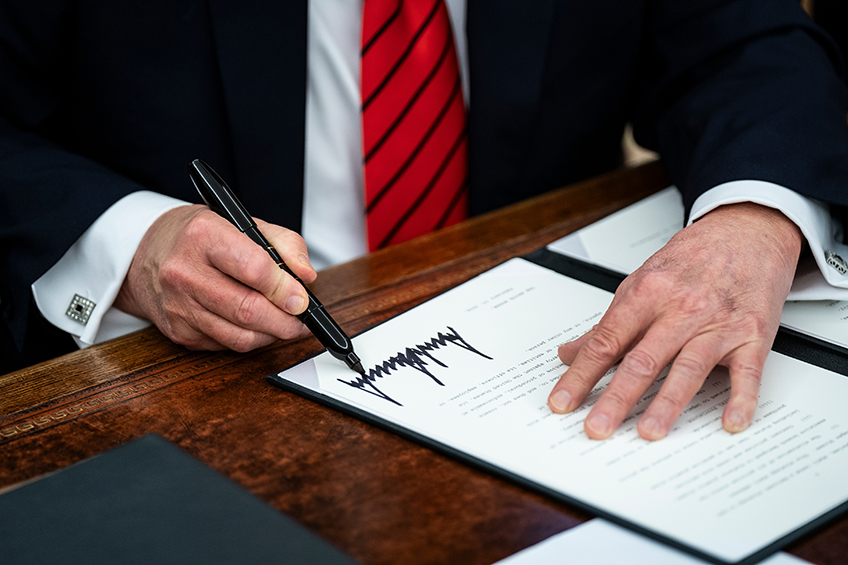There are growing indications that President Trump could be considering a retreat from his aggressive tariff stance. Over the last week, I have traveled across an evolving North America—from Arizona, through Washington D.C., and up to Saskatchewan, Canada—where I witnessed unmistakable signs of major transformations in the global economy. Uncertainty hangs heavy, with few confident predictions about the direction ahead.
A walk from the White House Rose Garden to the International Monetary Fund (IMF) headquarters takes merely nine minutes. Yet within that short distance, two contrasting realities have clashed dramatically in recent days.
Earlier this month, President Trump, using a dramatic chart and a debatable economic formula, unveiled his concept of “reciprocal tariffs.” Now, just a few weeks later, world finance ministers gathered at the IMF headquarters, attempting to manage the aftershocks even as global markets remained unsettled.
Throughout the IMF’s high-level meetings, which included discussions among G7 and G20 countries, a remarkable dynamic unfolded. U.S. officials encountered not open anger, but widespread dismay and deep concern from almost every other nation, fearing a rollback of hard-won global recovery following years of pandemic, conflict, and energy disruptions.
East Asian representatives voiced the most pointed criticisms, still reacting to earlier American accusations that characterized them as “looters and pillagers” of U.S. jobs due to their favorable trade balances, despite their strong historical alliances with Washington.
Japan, in particular, expressed quiet but firm dissatisfaction. Reports suggest that disillusionment over Washington’s shifting trade position triggered a wave of Japanese selling of U.S. government bonds. Finance Minister Katsunobu Kato called the new tariffs “highly disappointing,” warning of damage to both economic growth and financial stability.
This atmosphere echoed the IMF meetings of 2022, when ministers from developing countries expressed concern over the United Kingdom’s political instability during the short-lived Liz Truss administration. Then, as now, a traditional source of global economic leadership was under scrutiny.
Signals of Change
Facing volatile bond markets, signs of a possible U.S. recalibration have emerged. Washington has offered several overtures to China in recent days, praising its economic achievements and proposing a “beautiful rebalancing” of global trade— a sharp contrast to the earlier accusations of exploitation.
Despite these diplomatic efforts, a planned meeting between U.S. Treasury Secretary Scott Bessent and his Chinese counterpart ultimately did not take place. Nonetheless, many international delegations interpreted the signals as indications that Washington may be adjusting its trade strategy, even if it has yet to officially acknowledge it.
Rather than launching retaliatory measures, many countries are allowing internal U.S. market pressures to take the lead, particularly as corporate leaders from companies like Walmart and Target reportedly warned the White House about potential inventory shortages beginning in May.
The steep decline in container traffic from Chinese ports to Los Angeles—the critical artery of 21st-century global commerce—has become a vital metric. IMF economists, tracking satellite imagery, have reported a visible slowdown in shipping, even though U.S. officials continue to downplay these findings.
Behind the Scenes at the White House
By the end of the IMF sessions, a more subdued tone prevailed. This shift was largely credited to Treasury Secretary Scott Bessent, who appeared to take control of the tariff narrative and calm jittery markets.
Diplomatic sources suggest that Bessent’s rise followed internal drama. According to accounts, a senior White House adviser distracted tariff hardliner Peter Navarro with a fictitious meeting, allowing Bessent to directly present market concerns to President Trump.
Wall Street leaders reportedly advised that removing Navarro from his influential position could restore market confidence. However, insiders point out that Navarro’s political loyalty—cemented during the events surrounding January 6—makes such a move unlikely.
At best, the entire episode resembles a real-time political drama, highlighting how critical economic decisions are now entangled with domestic political maneuvering. At worst, uncertainty itself has become a larger threat than any single policy.
Uncharted Financial Territory
This climate of uncertainty has given rise to increasingly complex scenarios. In times of global stress, central banks rely on “swap lines” to ensure liquidity in U.S. dollars. Recently, however, some have begun to contemplate what might happen if Washington were to politicize access to these crucial financial instruments.
While such a scenario remains highly unlikely, its mere consideration reflects how seriously some institutions are now assessing future risks. Similarly, discussions have emerged about whether countries with trade surpluses could be asked to shoulder greater costs related to their holdings of U.S. government debt—an idea floated by some American policy thinkers.
Misinformation and speculation have already unsettled markets. After the initial tariff announcements, a sudden sell-off of U.S. government bonds sparked theories about China reducing its holdings. However, with Japan currently the largest holder, some suggest that Tokyo may have initiated sales to send a diplomatic message—though this remains speculative.
Market Caution Remains
While Secretary Bessent has publicly insisted that U.S. government bonds remain a safe and secure investment, the fact that he felt compelled to do so underlines persistent concerns.
Senior finance officials noted that few international counterparts appeared desperate to curry favor with Washington, reinforcing the idea that U.S. markets themselves would act as the ultimate constraint on American policy.
The specifics of the proposed 10% baseline tariff remain unclear. President Trump’s remarks suggesting that tariff revenue could significantly offset income taxes imply that he remains committed to the policy.
As one G7 diplomat observed, conflicting messages have emerged from different parts of the U.S. government, making it difficult to discern a consistent strategy. Ultimately, the direction will likely reflect the President’s evolving political and economic calculations.
Strategic Dimensions
A broader strategic question looms: could the U.S. be using tariff measures as part of a larger effort to align allies against China? If that is the case, the alienation of key partners, including Spain, raises questions about the coherence of that approach.
Spain has recently strengthened economic ties with China, securing major investments in electric vehicle manufacturing and technology. Prime Minister Pedro Sánchez, following a visit to Beijing, emphasized the importance of economic engagement with China within a broader security framework.
Speaking at the Semafor World Economy Summit, Spanish Finance Minister Carlos Cuerpo underscored the need for open trade with China, stressing that attracting Chinese investment remains crucial for Spain’s economic strategy.
Madrid’s position, bolstered by its status as one of the fastest-growing advanced economies, underscores the challenge Washington faces in building a unified front among allies.
High Stakes in the Coming Weeks
Canada’s political landscape may also shift following its upcoming elections, with the new Prime Minister likely playing a central role in shaping G7 discussions and broader trade negotiations.
The G7 Summit scheduled for June in Canada will coincide with the expiration of President Trump’s self-imposed 90-day tariff review period. Trump is expected to attend the summit, held in Alberta—a province he has spoken of in particularly favorable terms.
A path to de-escalation remains open, but serious risks endure. The coming weeks could prove decisive for the stability of the world economy.



